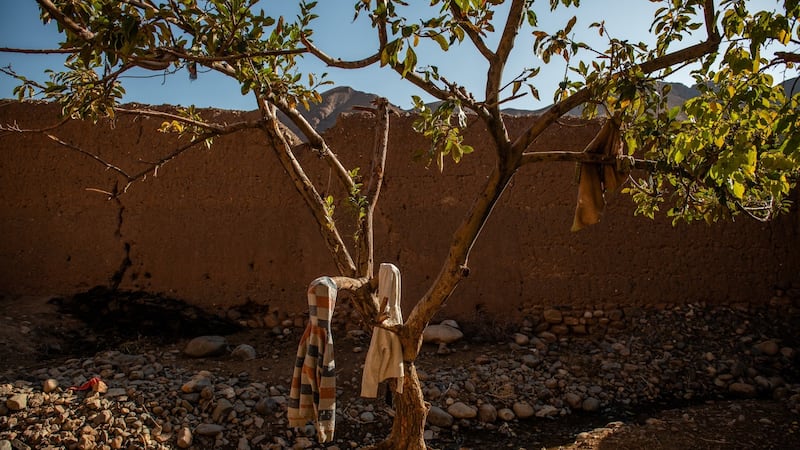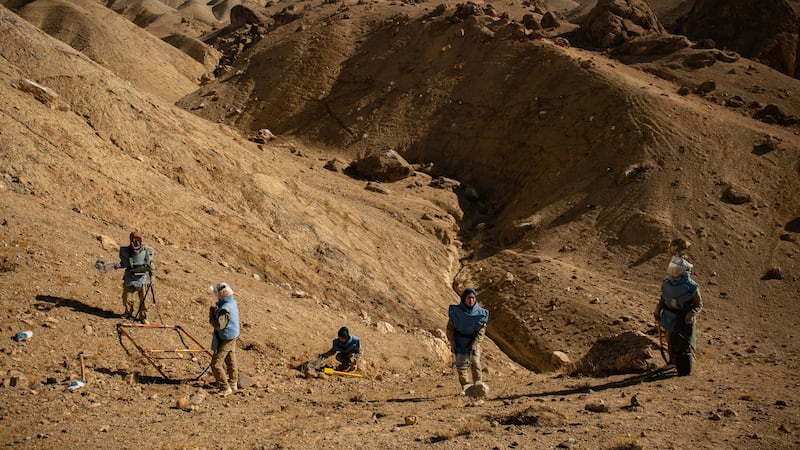The three boys were buried on the southern face of the mountain in May. The side-by-side graves of the brothers Amir Khan and Liaqat are marked with a green flag. Mujtaba’s grave is covered in a rocky mound and light from the morning sun.
It was a Soviet bomb, dropped from an aircraft decades before in 1986, that killed them this spring in Bamiyan province. The crudely welded silver cylinder, just bigger than a soda can, was one of many others ejected from a cluster bomb as it fell through the sky before resting in a shaded rocky ravine for 33 years.
Accounts of children finding old bombs and accidentally setting them off have become a central part of Afghanistan's story, horrifying in how frequently it is repeated. The deaths of the boys in Bamiyan, a relative haven from the fighting all around the country, are a particularly cruel example of the hidden dangers in Afghanistan.
War after war, piling on each other for decades, has left Afghanistan covered in well more than 1,000 square kilometres of mines, unexploded munitions, roadside bombs and shuttered firing ranges, according to Afghan government data. Many hazards have been marked, cordoned off, cleared or avoided.
But many also remain undiscovered. In 2018 alone, about 118 civilians were wounded or killed each month from buried explosives in Afghanistan, according to Afghan government data, a threefold increase since 2013.
Each one, the result of an often-forgotten battle or error, has the power to permanently devastate families and their communities.
That was the case on the mountain that looms over the boys’ village: Dahana-e-Ahangaran, a small collection of compounds forming a peninsula of green trees and potato fields along a single dirt road into the surrounding hills.
Before May 17th, when the bomb exploded, the sandstone mountain was a playground, a place for families to hike or gather, a grazing stop for livestock. Now it is a crime scene, feared and avoided, a shrine of grief. Ultimately, it will be logged as a data point in a galaxy of charts and graphs attempting to describe the destruction inflicted on this country over generations.
Military convoys
For Mohammad Bakhsh, Amir Khan and Liaqat’s father, the mountain has been a lifelong landmark in his backyard. He is 45 now, and was just six when the outcropping briefly turned into a battleground. Back then, it was an outpost for the US-supported insurgents who were fighting Soviet invaders. The mountain’s elevation, boulders and view of the surrounding valleys made for ample protection against the military convoys navigating the single road below.
Bakhsh says he does not recall much of the fighting other than that the insurgents had the high ground and the Soviets did not. He does not remember the plane that dropped the bomb that would one day kill his sons and their friend. And he does not remember the day the Soviets killed his father, who was among those fighting the Russians in a nearby village.
In the years after, the Soviets left the country, there was a civil war, the Taliban took power, and then the US-led invasion began in 2001. Dahana-e-Ahangaran has remained almost entirely sheltered from the violence since then: 18 years of relative peace, carrot picking and potato farming.

For Bakhsh’s sons, and for much of the rest of their community, the mountain was a place both to escape and to forage for refuse that could be sold at the bazaar. Shopkeepers bought scrap metal from its slopes and the ferula plants that grew out of the sand could be ground up for medicinal use.
“I didn’t force them to work; I wanted them to have a better future,” Bakhsh said of his sons. Liaqat was 14, Amir Khan was 12. On May 17th, Bakhsh, a taxi driver in winter and a potato farmer in summer, started the day by having the boys help push start their beaten blue station wagon, shoving it down the village’s road until the engine finally caught. It was a daily part of their routine when Bakhsh was not in the fields.
The two boys had already made plans that morning. Alongside Mujtaba (13), and other boys from their school, Amir Khan and Liaqat – bags in hand for anything they could find and sell – announced they were both “going to the mountain”.
Loud blast
At about 11am, an hour or so after Bakhsh dropped his sons off on the main road that skirts the foot of the mountain, he heard an explosion. Everyone heard it, he said, but he thought little else about the blast until he got home that night.
His four other children were inside their small, mud-walled compound, ready to break their daily fast during the holy month of Ramadan. But Amir Khan and Liaqat were not back from the mountain yet. Bakhsh, his heart sinking, gathered a dozen people to search through the night. They found the bodies the next morning.
United Nations deminers began excavating the area in October, steadily piling up a small set-piece of the Afghan-Soviet war: a Russian parachute flare and steel ammunition tins. Shell casings from Kalashnikovs and heavy machine guns. The deminers also found one unexploded artillery shell and two Soviet-era bombs like the one that killed the boys.
The munitions were destroyed. On the mine-clearing team’s hand-sketched map, the symbol that depicts the site of the explosion looks like a red rising sun. It is simply labelled “accident point”. There is no mention of the boys’ injuries, or the fact that the only way to identify them after the blast was by what clothes they were wearing.
Zahra Hassani, a 26-year-old deminer from Bamiyan, said it was the first time she had responded to such an accident. “Clearing this area makes me nervous,” she said, referring to where the bomb exploded. “But this is about kids’ lives.”
The bomb that killed the three boys is an AO-1SCh, the Russian designation roughly translating as cast-iron fragmenting munition. The small, poorly welded can – one of 150 or so ejected from a larger canister as it was dropped – contains over 40 grammes of high explosives within its cartoonish-looking frame.
Cluster bombs
Soviet cluster munitions are not the only ones littering Afghanistan. Between 2001 and 2002, the United States dropped roughly 1,228 cluster munitions of its own in the country, killing at least 60 civilians. More conventional ordnance dropped by US, Nato and Afghan forces in the years since has added to the threat.

And there is more: the pernicious improvised bombs the Taliban hide to attack convoys and patrols. They are one of the leading causes of civilian casualties in recent years. Nobody knows exactly what set off the bomb that killed the boys. Some in the village said the boys were throwing rocks at it, others said they were trying to pick it up and sell its parts for scrap, even though they had been taught about the dangers of unexploded ordnance and mines in school.
Samiullah (14), one of the boys who accompanied the three up the mountain, spent the morning with them before returning. They were not finding enough metal to fill their bags, so he wanted to return home. “I told them take my bread in case you’re hungry later, and I left,” Samiullah said. He will not go near the mountain now.
The three boys were buried on the mountain because Dahana-e-Ahangaran’s cemetery was full. In the days afterward, Bakhsh donated his sons’ clothes to the roughly 30 families in the village. He kept two hooded sweatshirts that his younger children now wear.
Every Friday, at 7am, the family piles into the blue station wagon to drive to the foot of the mountain and take the 10-minute hike up to the grave-studded plateau. Now, without his oldest boys, Bakhsh has no one at home to help push-start the car. So on a recent Friday, with a cold frost on his fields, Bakhsh patiently waited until his neighbours appeared, placed their hands on the bumper and pushed. (New York Times)









